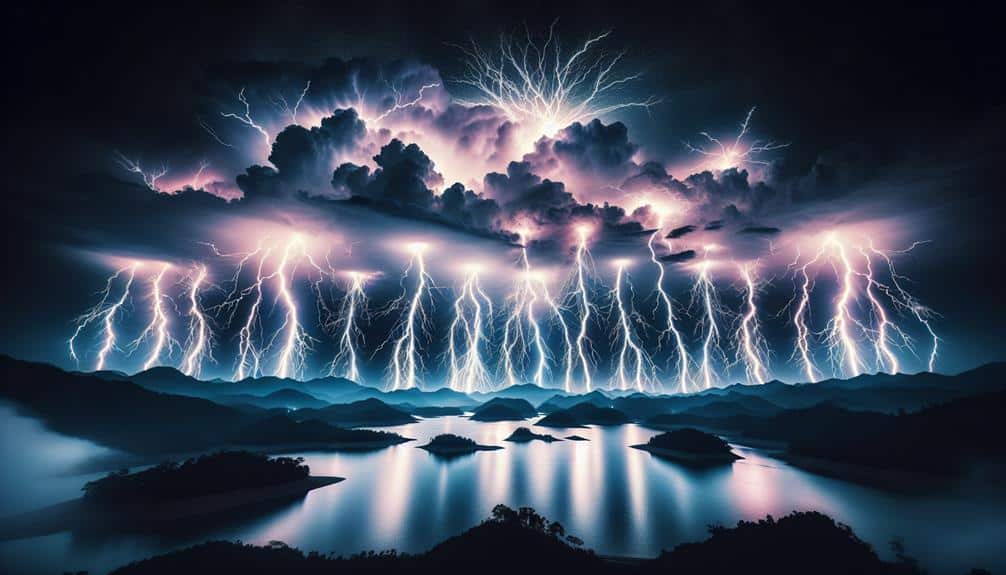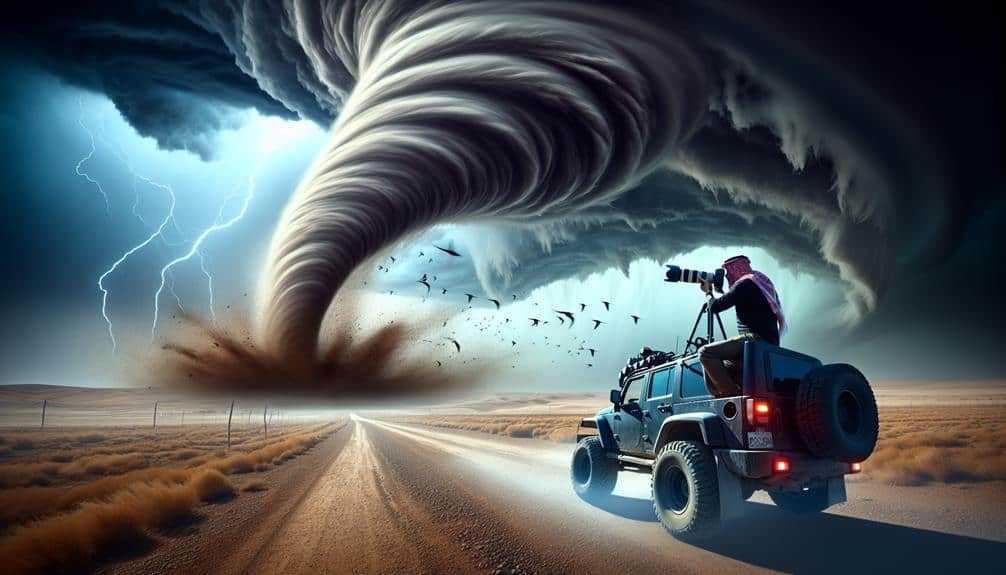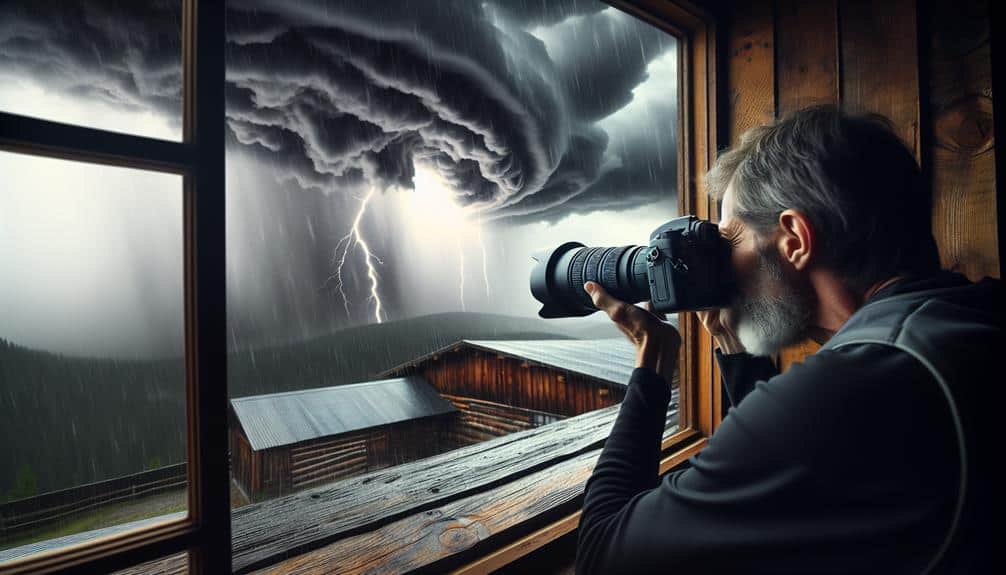We capture time-lapse videos because they provide essential data for analyzing dynamic weather patterns and refining predictive models. These videos visualize storm development by capturing real-time atmospheric changes, enabling us to identify pivotal shifts that precede severe weather. By documenting minute-by-minute cloud formations, wind shifts, and precipitation changes, we enhance our understanding of storm evolution and atmospheric instability. This data not only aids in real-time predictions but also supports scientific research and educational outreach. Our time-lapse footage fosters an appreciation for meteorological phenomena and underscores the significance of adept storm tracking methods. Let's explore how these insights revolutionize forecasting.
Key Points
- Time-lapse videos capture detailed dynamic weather patterns, aiding storm chasers in understanding meteorological phenomena.
- They enhance predictive accuracy by visualizing storm development and identifying changes preceding severe weather events.
- Real-time visualization of storm development provides crucial insights for weather forecasting and scientific research.
- Time-lapse footage streamlines data collection, allowing for efficient analysis of storm dynamics and pattern identification.
Capturing Dynamic Weather Patterns
Capturing dynamic weather patterns requires a deep understanding of meteorological phenomena and the technical skills to operate time-lapse photography equipment effectively. When we begin storm tracking missions, our goal is to document weather events with precision. By leveraging our knowledge of atmospheric dynamics, we can anticipate the formation and progression of storm systems. This allows us to position our equipment strategically, making sure we capture the most compelling footage.
Time-lapse photography is invaluable for weather documentation. It compresses hours of atmospheric changes into mere seconds, revealing patterns and behaviors that are otherwise imperceptible in real-time. By analyzing these time-lapse sequences, we gain insights into the lifecycle of storms, including cloud formation, movement, and dissipation.
Our data-driven approach involves using meteorological models and satellite imagery to identify potential storm activity. We then deploy high-resolution cameras equipped with intervalometers to capture images at set intervals. This meticulous process ensures that our time-lapse videos aren't only visually stunning but scientifically significant as well.
Ultimately, our commitment to capturing dynamic weather patterns empowers us to document nature's most unpredictable phenomena. This approach not only satisfies our desire for freedom but also provides valuable information to the field of meteorology.
Enhancing Predictive Accuracy
By leveraging time-lapse videos, we can capture real-time weather patterns with unparalleled detail, enhancing our predictive models. This method boosts data collection efficiency, providing high-resolution temporal data.
Additionally, visualizing storm development through time-lapse aids in identifying crucial changes that precede severe weather events.
Real-Time Weather Patterns
Utilizing real-time weather patterns in time-lapse videos enhances our ability to predict storm behavior with greater precision. These videos offer a dynamic perspective that static images simply can't match. When we analyze these visuals, we gain critical insights into the formation, development, and movement of storms. This enhanced view aids in weather forecasting and scientific research, allowing us to interpret data more accurately and make timely decisions.
Incorporating real-time weather patterns into our meteorological analysis is transformative. We can observe cloud formations, wind shifts, and precipitation changes as they happen, providing a thorough understanding of storm dynamics. For those of us committed to climate studies, these time-lapse videos serve as an essential tool to track atmospheric changes and predict future weather events with increased reliability.
Moreover, by leveraging this technology, we can refine our predictive models, ensuring they're both robust and adaptive. This empowers us to act swiftly and efficiently, making informed decisions that can save lives and mitigate property damage. It's not just about watching a storm unfold; it's about harnessing the power of real-time data to enhance our forecasting capabilities and contribute meaningfully to meteorological science.
Data Collection Efficiency
To enhance predictive accuracy, we must streamline data collection methods, ensuring we capture high-resolution meteorological data efficiently and effectively. Leveraging time-lapse videos plays an essential role in this process. By converting hours of footage into condensed sequences, we can analyze storm dynamics with improved accuracy. This method allows us to identify patterns and anomalies faster, providing essential insights that static images or real-time footage might miss.
Time-lapse technology also supports the compilation of vast datasets without overwhelming our storage capacities. By focusing on key temporal intervals, we reduce data redundancy and enhance the clarity of the information we gather. This streamlined approach enables us to process and interpret data in real-time, offering faster insights essential for timely decision-making.
Moreover, integrating high-resolution time-lapse videos with other meteorological tools like Doppler radar and satellite imagery creates a multi-dimensional data environment. This fusion of technologies enhances our predictive models, allowing for more precise storm forecasts. The result? We're better equipped to anticipate severe weather events, minimizing risks and maximizing safety.
In essence, optimizing data collection through time-lapse videos not only refines our predictive capabilities but also empowers us to respond swiftly and accurately in the face of nature's most formidable forces.
Visualizing Storm Development
Harnessing the power of time-lapse videos, we can visualize storm development with unprecedented clarity, enabling us to detect subtle atmospheric changes and refine our predictive models. These videos provide a dynamic form of weather documentation, capturing the progression of storm systems in a way that static images or traditional video cannot. By compressing hours or days of storm activity into a few minutes, we gain insights into cloud formation, wind patterns, and precipitation cycles.
Scientific visualization through time-lapse videos enhances our storm tracking capabilities. We observe the evolution of key meteorological phenomena like cumulonimbus cloud build-up, supercell rotation, and frontal boundary interactions. This helps us fine-tune our predictive algorithms, making forecasts more accurate and timely. The rapid temporal resolution provided by time-lapse technology allows us to identify early signs of severe weather, improving public safety measures.
Moreover, these videos aren't just scientific tools; they're also a form of artistic expression. They capture the awe-inspiring power and beauty of nature, resonating with an audience that values both freedom and knowledge. As storm chasers, we combine scientific rigor with creative artistry to not only understand but also appreciate the majesty of our planet's weather systems.
Documenting Storm Evolution
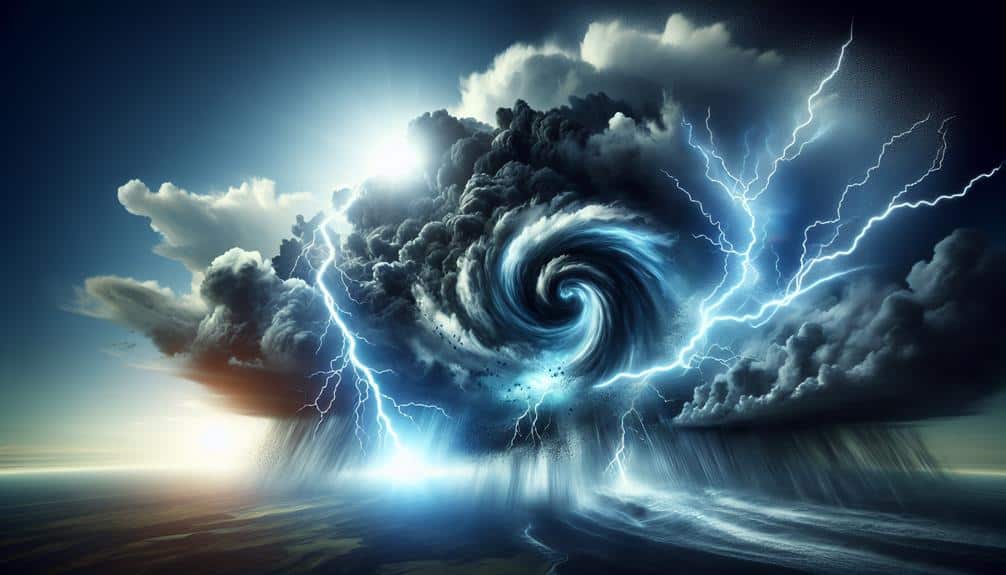
When we document storm evolution through time-lapse videos, we capture storm dynamics in unprecedented detail. These recordings allow us to visualize weather patterns and track their changes over time.
Capturing Storm Dynamics
Utilizing time-lapse photography allows us to meticulously document the dynamic evolution of storm systems, revealing patterns and behaviors that are often imperceptible in real-time observation. This technique enables enhanced weather documentation, capturing the intricate details of storm dynamics such as the formation of supercells, the rotation of mesocyclones, and the rapid development of thunderstorm anvils. By compressing hours of footage into a few minutes, we can visualize storm evolution with unprecedented clarity.
Our time-lapse recordings serve as a valuable tool for storm visualization, allowing us to identify critical phases in storm development and progression. For instance, the accelerated sequences highlight the rapid updrafts and downdrafts, showcasing the vertical motions within the storm that contribute to phenomena like hail formation and tornado genesis. Detailed documentation of these elements is essential for refining predictive models and improving our understanding of severe weather mechanisms.
Moreover, time-lapse footage provides empirical data that can be analyzed for rotational speeds, cloud base lowering, and other key indicators. This data-driven approach not only enriches our scientific knowledge but also empowers us with the freedom to make informed decisions in real-time storm chasing, maximizing both safety and observational accuracy.
Visualizing Weather Patterns
Through time-lapse footage, we can carefully observe the intricate weather patterns that underlie storm evolution, providing essential insights into phenomena like cloud formation dynamics and atmospheric instability. These videos allow us to capture minute-by-minute changes in the atmosphere, offering a clear view of how storms develop, intensify, and dissipate over time. By documenting these progressions, we gather invaluable data that contributes to our understanding of weather phenomena and the broader implications of climate change.
Time-lapse technology enables us to see patterns that would otherwise be imperceptible in real-time. The acceleration of footage compresses hours or days of weather activity into a concise visual narrative, making it easier to identify key elements such as updrafts, downdrafts, and the formation of various cloud types. This detailed visualization aids in predicting future storm behavior, potentially saving lives and mitigating property damage.
The emotional impact these visuals can have on us is profound:
- The awe-inspiring beauty of nature's power
- The stark reality of our planet's changing climate
Understanding these weather phenomena through time-lapse footage empowers us to respond more effectively to the growing challenges posed by climate change.
Analyzing Formation Processes
In our analysis of storm formation processes, we meticulously document each stage of storm evolution, from initial cloud development to full-fledged storm systems, using high-resolution time-lapse footage. This approach allows us to capture minute changes in the atmosphere, providing invaluable data for our formation analysis.
By condensing hours of weather evolution into seconds, we can identify patterns and structures that are often overlooked in real-time observations.
Using time-lapse videos, we track the rapid development of cumulonimbus clouds, monitor the shift from updrafts to downdrafts, and observe the formation of mesocyclones. These visual records are essential for understanding the intricate dynamics involved in storm genesis.
For example, we can measure the speed of cloud base rotations, quantify the growth rate of storm cells, and assess the life cycle of supercells.
Our data-driven approach guarantees that we're not just observing, but actively analyzing the mechanics behind storm development. This detailed documentation aids in refining predictive models and enhances our ability to forecast severe weather events.
Ultimately, it's about leveraging technology to gain deeper insights into nature's most powerful phenomena, thereby empowering us to make more informed decisions and expand our knowledge of atmospheric sciences.
Showcasing Nature's Power
Time-lapse videos vividly capture the raw power of nature by compressing hours of dynamic weather patterns into just a few seconds, revealing intricate details and behaviors that are otherwise imperceptible to the human eye. When we track extreme weather, these videos are invaluable. They allow us to witness natural phenomena like supercell thunderstorms, tornado genesis, and lightning formation with unprecedented clarity.
Through time-lapse, we can observe the rapid development and dissipation of storm clouds, the swirling motion of tornadoes, and the striking patterns of lightning. This visual data isn't only breathtaking but also essential for our scientific understanding. We can analyze factors such as cloud morphology, storm cell rotation, and atmospheric instability more efficiently.
By showcasing nature's power, we can inspire awe and respect for the forces that shape our environment. Here's what we often feel:
- Awe: Witnessing the sheer scale and intensity of these natural events.
- Respect: Understanding the formidable power and unpredictability of extreme weather.
Time-lapse videography transforms our perception of natural events, providing a unique window into the fundamental processes that govern our world.
Engaging Visual Storytelling
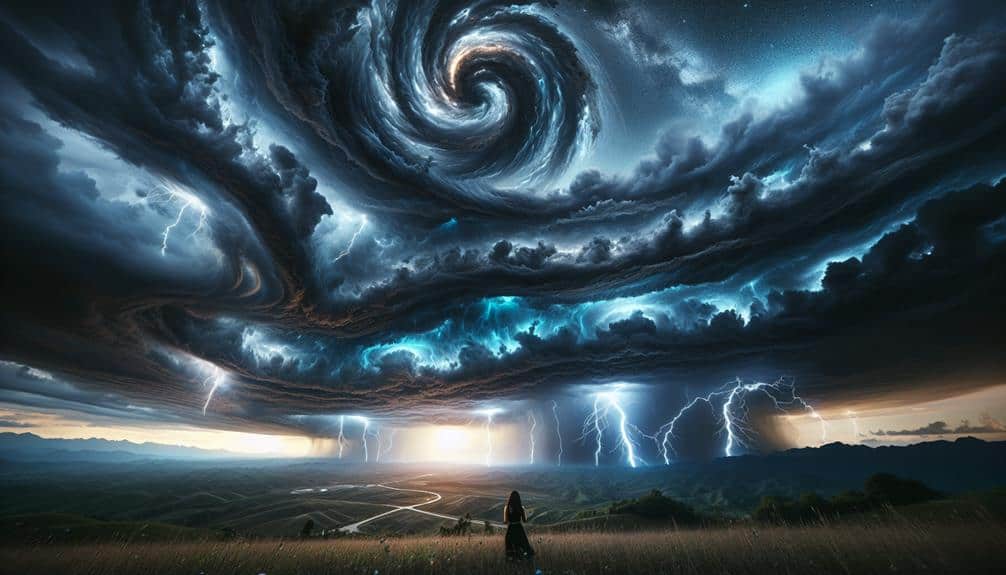
Engaging visual storytelling utilizes time-lapse videos to craft compelling narratives that explain the intricacies of storm dynamics and atmospheric phenomena. By accelerating the passage of time, we can observe the rapid evolution of cumulonimbus formations, mesocyclones, and supercells. This technique enables us to capture the intricate dance of air masses, moisture, and thermal gradients, making the invisible forces of nature visible and understandable.
In our creative editing process, we focus on assembling these sequences to reveal the underlying patterns and behaviors of storms. By doing this, we not only showcase the raw power of nature but also create an emotional impact that resonates with viewers. The contrast of serene, pre-storm environments with the ensuing chaos of a tempest amplifies the dramatic tension, drawing viewers into the narrative. This approach fosters an appreciation for meteorological science while fulfilling the human desire for freedom and exploration.
Furthermore, the emotional impact of these visual stories encourages a deeper connection with the natural world. As we observe a storm's lifecycle compressed into mere minutes, we gain a profound respect for the atmospheric forces at play. Time-lapse videos, in this way, serve as a bridge, connecting scientific understanding with human experience.
Supporting Research and Education
Harnessing the power of time-lapse videos not only captivates audiences but also supports research and education by providing a dynamic tool for analyzing storm structures and behaviors in unprecedented detail. Through time-lapse technology, we can compress hours of storm development into seconds, revealing patterns and phenomena that are imperceptible in real-time footage. This data-driven approach offers numerous research benefits, enabling meteorologists to refine predictive models and enhance our understanding of severe weather systems.
Moreover, time-lapse videos hold substantial educational value. They provide an engaging medium for teaching complex meteorological concepts, making it easier for students and enthusiasts to grasp the intricacies of storm dynamics. By visually demonstrating processes such as supercell formation, updrafts, and downdrafts, time-lapse videos transform abstract theories into observable realities.
Inspiring Awe: Witnessing the raw power of nature condensed into a brief clip evokes a profound sense of wonder and curiosity.
Fostering Understanding: Time-lapse videos simplify the learning process, breaking down complicated phenomena into digestible visual segments.
Encouraging Exploration: These videos motivate individuals to explore further into meteorology, fostering a culture of continuous learning and discovery.
In essence, the integration of time-lapse videos into research and education not only advances scientific knowledge but also empowers individuals to investigate the fascinating world of storm chasing with newfound clarity and enthusiasm.
Building a Portfolio
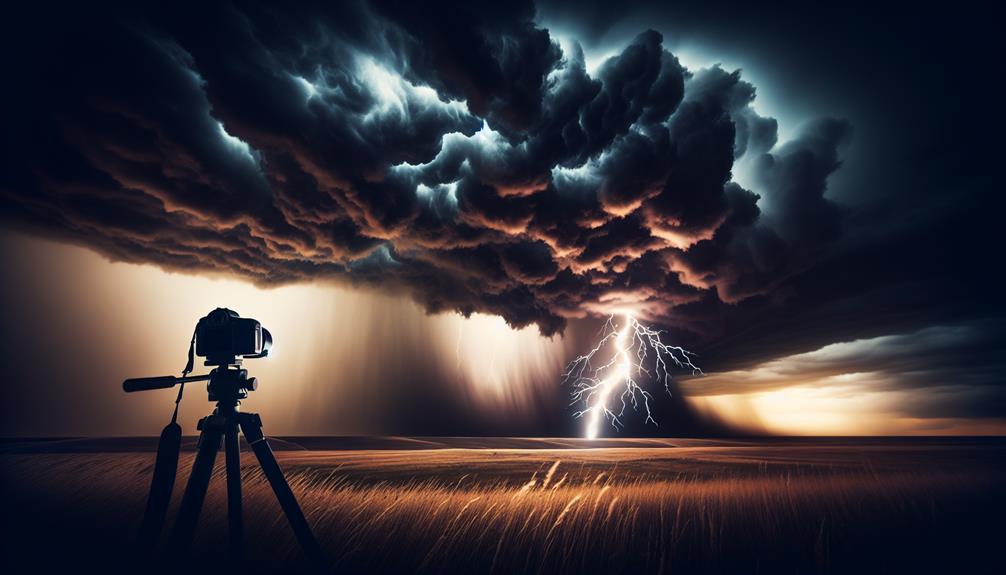
Creating a thorough portfolio of time-lapse storm videos necessitates a strategic approach, focusing on capturing diverse weather phenomena and meticulously documenting each event's meteorological context. We need to prioritize high-quality footage of various storm types, such as supercells, squall lines, and mesoscale convective systems.
By integrating synoptic charts, radar images, and atmospheric data, we enhance the scientific rigor of our portfolio presentation, showcasing skills in both videography and meteorological analysis.
For career advancement and professional development, our portfolio should demonstrate not only our technical proficiency but also our ability to interpret complex weather patterns. Each video must be accompanied by detailed annotations that explain the meteorological conditions, such as wind shear, dew point, and CAPE (Convective Available Potential Energy). This detailed approach not only highlights our observational skills but also our capacity for data-driven analysis.
To maximize our professional opportunities, we should continuously update our portfolio with recent storm events, ensuring it reflects our evolving expertise. By maintaining a dynamic and scientifically thorough collection, we position ourselves as valuable assets in fields like meteorology, climate research, and media production, ultimately fostering both our professional growth and creative freedom.
Frequently Asked Questions
What Equipment Is Essential for Creating High-Quality Time-Lapse Videos of Storms?
Isn't the magic in capturing storms all about precision? We need a high-resolution camera, best camera settings for exposure, and unwavering tripod stability. These elements guarantee we document the breathtaking power of nature in stunning detail.
How Do Time-Lapse Videos Affect Public Awareness and Safety During Severe Weather Events?
Time-lapse videos enhance public education and community engagement by visually demonstrating storm development. They aid weather forecasting and improve emergency response, ultimately increasing public awareness and safety during severe weather events through clear, data-driven visualizations.
Can Time-Lapse Videos Be Used for Commercial Purposes, Such as in Advertisements or Films?
Imagine a lightning bolt captured mid-strike. We can harness time-lapse videos for the film industry and marketing campaigns, transforming them into engaging promotional materials and social media ads, effectively captivating audiences with scientifically accurate, visually stunning content.
What Are the Legal Considerations for Storm Chasers When Filming Time-Lapse Videos?
When filming time-lapse videos, we must consider privacy concerns and adhere to drone regulations. Ensuring compliance with local laws and respecting individual privacy rights are essential to maintaining ethical standards and avoiding legal repercussions.
How Can Amateur Storm Chasers Get Started With Time-Lapse Videography?
To capture the dance of clouds, we need to master camera settings like interval timing and exposure. Let's also embrace editing techniques to enhance our footage. This combination reveals the freedom to create stunning time-lapse videos.
